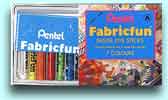Click here to Buy

Bright Crayola Fabric Markers
from Joann.com
Drawing lots of stuff by hand on a shirt is certainly more time-consuming than any of the other techniques I mention. The biggest problem is that markers contain transparent ink, and thus require a white background.
I usually use Marvy fabric markers. Except on baby clothes, I've found these to be amazingly long-lasting, though they require no heat setting at all. The colors can be blended rather well for a felt-tip pen. The baby clothes problem was probably bleach--white is not the best choice of backgrounds for baby clothes, but is fine for most adults. I got the fabric markers at a wonderful local arts supply store, Texas Art Supply; if you don't have access to that, try another crafts store, or try Dharma, which carries the full range of colors. (See Sources for materials.)
Besides their use for drawing complete pictures on clothing, fabric markers have many potential uses in adding details to other types of designs. You could add antennae to stamped insects, or fins to stamped fish, or have fun coloring in the spaces left after stamping or printing in black.
Caution: do not use any marker that does not claim to be permanent on fabric! Ordinary markers will not do. You must use fabric markers. Ordinary permanent markers are apt to wash out eventually.
Advertisements
Click Here to Buy Pentel FabricFun Pastel Dye Sticks from Mister Art
Pentel FabricFun Pastel Dye Sticks from Mister Art
Many different fabric paints are suitable for printing or painting with a brush. All you have to do for printing is use a small foam brush to apply the paint to whatever you're using to print with, then apply the item with the wet paint on it to the fabric. Some fabric paints leave a nasty, hard feeling on the fabric, like latex house paint; others are very thin and almost soft. "Slick" paints are unsuitable for painting large areas, partly because of the unpleasantness of the feel, and partly because if you are foolish enough to put them in the dryer (hey, I put everything in the dryer--it's too humid here for clothes to dry on a line!), the large painted areas can stick together. Fortunately, they always came apart again when pulled on while still warm.
A key point is that most fabric paints are transparent, and thus totally unsuitable for use on dark colors such as black or navy--the very colors that age best when worn by a messy child. Check carefully for claims of opacity. If it doesn't say it's opaque, assume that it is not. Metallic and pearlescent paints are usually opaque.
Transparent fabric paints can have beautiful effects when used on lighter colors, of course, really much more satisfying to the artist than the opaque paints on a black shirt, but far less satisfying to the child who wants a nice spaceship and solar system t-shirt!
For truly beautiful complex results, use metallic fabric paints on fabric that you have already dyed (and washed out, and dried); the layering of the different techniques adds a complexity and richness that is unavailable when any single technique is used alone. Preferred brands of metallic paints include Jacquard Lumiere Fabric Paint and Pearl-Ex Stamp Pads. Pearl-Ex pigments do not include a binder, and thus cannot be used for painting, but Pearl-Ex Stamp Pads are formulated with a fabric paint binder that makes them ideal for adding sparkle to fabric that will be laundered.
You can buy pre-cut sponges, or you can buy "pop-up" sponges that are pressed so thin and flat that you can cut out fairly detailed shapes with a pair of scissors with the greatest of ease. Then simply wet the sponge, and wring it out, before dipping it into paint or applying paint with a sponge. The holey texture of the sponge can overwhelm the design.
You can sometimes buy some great fabric stamps (see Katy Widger's book in my book reviews section). Ordinary paper stamps are less apt to be as satisfying, as the cut-out parts may not be deep enough to avoid printing. A very fine way to make your own stamps is to use a product that is a thin, paper-backed, self-adhesive sheet of rubber; I think the Dharma version is called Sure Stamp. Another option is to buy the blue Dr. Scholls foam inserts for work boots, and glue them to a backing. For backing material in either case, use a cheap child's wooden block, if handy, or scrap bits of Lucite or other thick sheets of acrylic. The latter has obvious advantages in placing the print in the exact right position on the fabric.
Most rubber stamps intended for paper will not print well on fabric, due to their tiny details. If you want to use detail paper-type rubber stamps on fabric, use synthetic fabric, with a stamp pad containing disperse dye, a kind of dye that works only on synthetics such as polyester. Stamp onto paper, and iron on to your polyester.
Screen printing is an excellent way to add prints to your fabric, using either thickened dyes or fabric paints, one of the very best ways to print a large run of t-shirts with a given slogan or design, but it seems like a lot of trouble to me. If you only want to do a few copies of a design, consider creating your own ink-jet iron-ons as described below.
Several companies, including Dharma Trading, now carry cotton or silk fabric that can be run right through a computer printer. How about a scarf printed with a photo montage? What an exciting idea!
Next: About Dyes....
Page created: August 4, 1998
Last updated: June 28, 2006
Downloaded: Wednesday, December 17, 2025